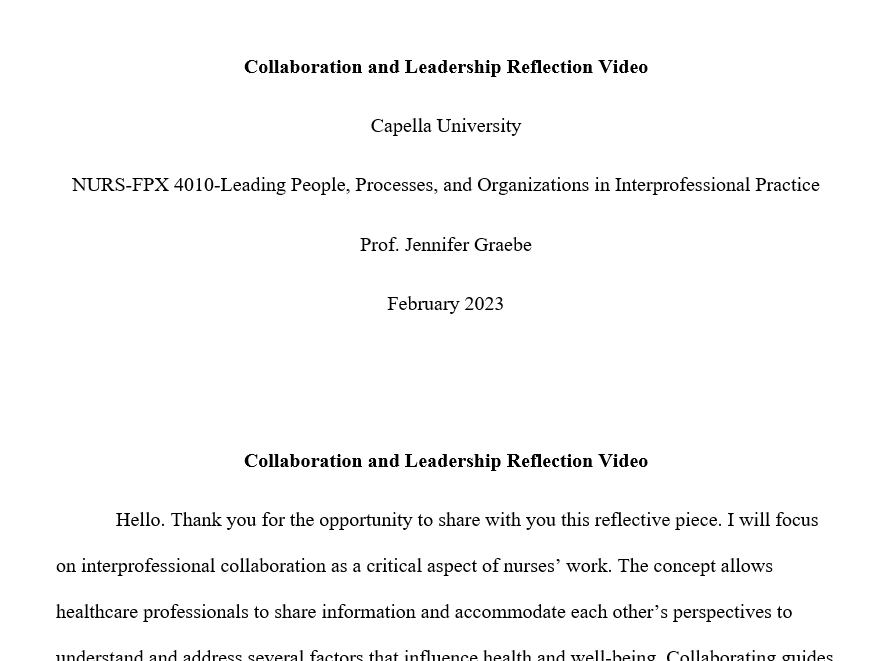NURS-FPX4010_T_Assessment 1-1 solution.docx
Collaboration and Leadership Reflection Video
Capella University
NURS-FPX 4010-Leading People, Processes, and Organizations in Interprofessional Practice
Prof. Jennifer Graebe
February 2023
Collaboration and Leadership Reflection Video
Hello. Thank you for the opportunity to share with you this reflective piece. I will focus on interprofessional collaboration as a critical aspect of nurses’ work. The concept allows healthcare professionals to share information and accommodate each other’s perspectives to understand and address several factors that influence health and well-being.
Collaborating guides healthcare professionals and patients to identify pathways for achieving the best outcomes. The Clarion Court Skilled Nursing Facility case highlights the need for a conducive environment that allows everyone to share suggestions on evidence-based strategies for implementing a new technology.
I will share my experience being part of an interprofessional team. I had the chance to be part of senior and junior healthcare staff assembled to investigate and provide findings on reasons for rising turnover rates among nurses. The team had the nurse manager, two physicians, three nurses, a clinical assistant, and an intern.
Worrying rates of nurse turnover meant that the organization required accurate and complete evidence on scenarios within the clinical environment that triggered the trend. My role was to synthesize information from records explaining reasons for nurses leaving the organization in the last two years.
The role meant that I had to process the reasons and capture similar reasons provided by nurses besides retirement. I managed to capture details about desire for career progression, burnout triggered by high patient acuity, attractive financial incentives, and education advancement. Sharing the findings with the rest of the team boosted my confidence and ability to present findings clearly.
One success from the interprofessional collaboration was the members’ commitment to embracing team-based functions throughout the process. Mogogolea and Jokonya (2018) emphasized the need for everyone to recognize shared aspiration and the need to fulfill duty of care by sharing accurate and complete evidence on the causes, implications, and solutions for nurse turnover.
Another success was the excellent relationship between senior and junior staff that made it easier for the latter to share views about scenarios that influenced nurse turnover. Effective interpersonal relations strengthened communication, making it easier for members to meet objectives of the process (Errida & Lotfi, 2021).
The team leader also demonstrated sound leadership traits and qualities characterized by active listening and willingness to help members throughout the process. However, the busy nature of members made it challenging to organize meetings.
The team chose Zoom as a viable means of sharing findings and engaging in interactions about nurse turnover and evidence-based solutions. Another challenge was the duration. The team felt that it had limited time provided by the hospital leadership. However, effective information flow and efforts to sustain team-based functions allowed the team to produce the report within the stipulated duration.
Best Practices for Interprofessional Collaboration
The Clarion Court Skilled Nursing Facility provides insights into the challenges and enablers of successful change management. A review of the series of events that took place at the facility revealed the need for transformational leadership, which is a people-centered approach that encourage team-based practices (Asif et al., 2019).
The right leaders inspire a shared vision based on clear description of strategic priorities and the relevance of the intended change on the hospital, the care team, and patients. The facility needs a transformational leader to allow everyone to share suggestions about the proposed change and the framework for achieving the best outcomes.
For instance, Silva, the administrator, identified problems upstream as a key challenge when implementing changes. The existing leaders could not balance short and long-term thinking. The leaders also did not know the staff and its needs, making it more difficult to achieve collective buy-in when implementing Healthix.
The transformational leader recognizes teamwork and collaboration as key consideration that allow the IT, operations, administrative, and nursing teams to participate in discussions about EHRs and their implications on workflows and patient outcomes (Mogogolea & Jokonya, 2018). Another important consideration for improving interprofessional collaboration is streamlining communication by eliminating power distance and hierarchical barriers across the continuum (Errida & Lotfi, 2021).
The move elicits positive reactions based on shared aspirations, participative behaviors, and meaningful conversations between health leaders and the rest of the workforce. Further, effective communication improves individual and collective ability to share accurate and complete details about limitations of the proposed EHR, alternatives, and improvements necessary to achieve the intended change.
As I conclude, this reflective experience is an opportunity to acquire knowledge, skills, and experience necessary for strengthening interprofessional collaboration. The Clarion Court Skilled Nursing Facility scenario provides insights into the need for effective leadership characterized by a people-centered style and ability to balance short-term thinking and long-term perspectives.
The transformational leader elicits collective buy-in by allowing individuals to share suggestions on best practices for designing and implementing changes.
References
Asif, M., Jameel, A., Hussain, A., Hwang, J., & Sahito, N. (2019). Linking transformational leadership with nurse-assessed adverse patient outcomes and the quality of care: Assessing the role of job satisfaction and structural empowerment. International Journal of Environmental Research and Public Health, 16(13), 1-13. https://www.ncbi.nlm.nih.gov/pmc/articles/PMC6651060/pdf/ijerph-16-02381.pdf
Errida, A., & Lotfi, B. (2021). The determinants of organizational change management success: Literature review and case study. International Journal of Engineering Business Management, 13, 1-13. https://journals.sagepub.com/doi/epdf/10.1177/18479790211016273
Mogogolea, K. E., & Jokonya, O. (2018). A conceptual framework for implementing IT change management in public sectors. Procedia Computer Science, 138, 835-842. https://www.sciencedirect.com/science/article/pii/S1877050918317563
Matusov, Y., Matthews, A., Rue, M., Sheffield, L., & Pedraza, I. (2022). Perception of interdisciplinary collaboration between ICU nurses and resident physicians during the COVID-19 pandemic. Journal of Interprofessional Education, 27, 1-4. https://www.ncbi.nlm.nih.gov/pmc/articles/PMC8804086/



